Mt. Hymettus Orchids
Welcome to Athens and our Orchids Album! The vast majority of the inquisitive visitors to Athens are usually facing a big dilemma: Spend some time here before their island hopping to the Aegean or abandon everything and rush to their dream destination as soon as possible? Trying to make a decision one is tempted, mainly or exclusively, by the Acropolis, dominating the city skyline, and the New Acropolis museum. Few are aware that in the same city, less than two miles away, there is one of the top museums worldwide, namely the National Archaeological Museum, full to the brim with masterpieces of prehistoric and historic art of utmost importance: the Mycenaean gold jewels and artifacts are just a few of these treasures. As if these were not enough, this album comes to make things worse. Because, once on the Acropolis rock, or even in the Acropolis Museum, your view to the east is blocked by Mt. Hymettus, a mountain offering one of the richest habitats as regards its flora. To the plant enthusiast Greece in general, Attica in particular, are "dreams come true" and exploring them, camera in hand, is an absolute must. The photos in this album (and the ones to appear in this site in the near future) are meant to be just an appetizer, hoping to make Mt. Hymettus appealing to the "beauty enthusiast" as well. If you wish to take part in a photographic plant safari to Mt. Hymettus, please do contact us. We'll take you around to spots where the chances of finding orchids are best. Late winter to midsummer is when they're more frequent: different species bloom at varying periods. The captions of the photos in this album inform you about the date they were taken.
Select Page of the Album:
Click on any of the pictures to enlarge.
Serapias bergoniiFull Name: Serapias bergonii E.G.Camus Common name: Bergon's serapias Taxonomy | Regnum | Plantae | | Divisio | Tracheophyta | | Subdivisio | Spermatophytina | | Class | Magnoliopsida | | Suoerordo | Lilianae | | Ordo | Asparagales | | Familia | Orchidaceae | | Subfamilia | Orchidoideae | | Tribus | Orchidae | | Subtribus | Orchidinae | | Genus | Serapias | | Species | Serapias bergonii | Serapias genus was named after Serapis, a syncretic Hellenistic-Egyptian god in Antiquity.
It is a genus of terrestrial orchids that can be found all over southern Europe to Asia Minor.
They have spurless flowers and usually go dormant during the winter seasons. Serapias bergonii grows in the east Mediterranean region. It is distinguished on the basis of the quite long flowers, yet smaller than the flowers of Serapias vomeracea with which it can easily be confused. It is generally shorter and less robust than S. vomeracea but probably the key feature which distinguishes the two is the length of the bracts relative to the hood. In this species the height of the bract is no more than twice that of the hood whereas in S. vomeracea the relationship can be more like three times and creates an impression of many church spires rising from a town skyline. This is most apparent in younger plants and becomes less obvious in older, taller specimens. The flowers have also the tendency to be positioned more or less vertically to the stem.
It flowers from March to the end of May.
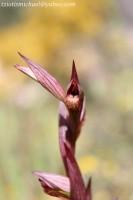
Serapias bergonii
Date taken: April 19, 2015 |
|
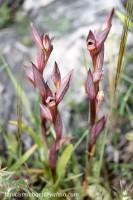
Serapias bergonii
Date taken: April 14, 2015 |
|
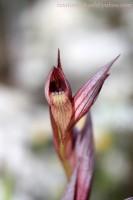
Serapias bergonii
Date taken: April 14, 2015 |
|
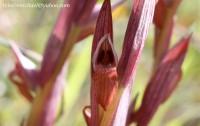
Serapias bergonii
Date taken: April 19, 2015 |
|
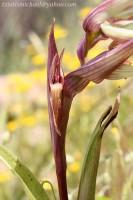
Serapias bergonii
Date taken: April 19th, 2015 |
|
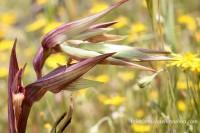
Serapias bergonii
Date taken: April 19th, 2015 |
|
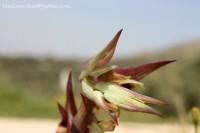
Serapias bergonii
Date taken: April 19th, 2015 |
|
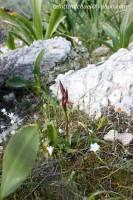
Serapias bergonii
Date taken: March 26th, 2014 |
|
Select Page of the Album:
|
|



